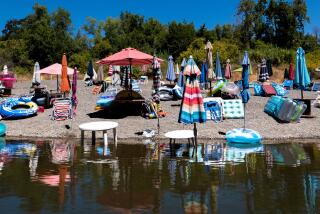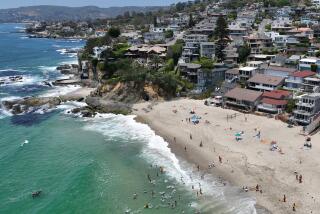Owner of Julian Surfing Store Makes Waves With 14-Foot Sign : Regulations: Whether the county is right or wrong to order the wave removed has residents of the rustic town divided--but everyone has an opinion.
Marcia Hegranes is making waves in this rustic mountain town a mile above sea level, a world away from the teen-inspired trends that dominate the Southern California coastline below.
One wave is a colorful 14-foot-high rendition of the real thing that Hegranes recently installed at her sporting goods shop--a popular youth hangout that occupies a Depression-era water tower not far from Main Street. The wave carries an inscription Hegranes is touting to hundreds of local young people: “Surf’s Up in Julian.”
Looming larger, though, is the stormy reaction of many people in the picturesque apple-growing center. They say the towering wooden wave arching over the doorway to Julian Surf & Sport just doesn’t fit the historic feel of the town. And that it has got to come crashing down.
“The wave, the wave, the wave--that’s all you hear people talking about in town these days,” said Derrick Leonard, owner of the water tower and an adjoining complex of craft shops.
“Nobody seems to agree about what should be done. They’re all taking up sides over the thing.”
Folks have been talking about the blue wooden wave since the day it sprang up in late October--including members of the Julian architectural committee, who say the thing doesn’t conform to the community standards established for outdoor facades.
Recently, San Diego County officials--apparently notified by several angry community residents--informed Hegranes her wave had until Christmas Eve to be dismantled. The deadline later was extended one month, at her request.
In the meantime, the businesswoman has received dozens of “Save the Wave” letters of support from residents who say that the wave is indeed a wacky and welcome touch in an isolated area otherwise dominated by antique and apple pie shops.
“As a mother and father of a teen-ager we wholeheartedly support Marcia’s shop, the wave artwork and her kindnesses to young people,” wrote one couple. “The kids are watching.”
For Hegranes, the debate over her business decor signifies how some Julian residents are still smarting from the sudden arrival of two fast-food chains last summer.
The opening of the Dairy Queen ice cream and Subway sandwich franchises changed the delicate character of the quaint turn-of-the-century mountain village, known for its hand-pressed cider and home-baked pies, many locals say.
“What’s happening to me is a fallout from the opening of those two franchises,” said Hegranes, a coastal transplant who moved to Warner Springs and the scenic mountain backcountry four years ago. “They’re scared that things are changing too fast around here. And they want to do something about it.”
For their part, officials say the wave just looms too big for the tiny town of 1,300 residents. It has nothing to do with the fast-food fallout. Rules, they say, are rules.
Hegranes, a grandmother of five who once ran a Carlsbad jewelry store, opened the tiny surf and sport shop in the fall of 1990 after decades of visiting Julian--and witnessing how little young people had to do there.
Now she sells stickers, skateboards and surf wear to an estimated 1,000 teen-age customers she says live in the nearby mountains. Fitting in with Julian’s main industry, a sign outside the shop shows a half-eaten apple with the inscription “Dedicated To The Hard-Core.”
The apple sign, she said, breezed through inspection from the local architectural committee--which reviews signs and add-ons to ensure they comply with restrictions in the town, a county-designated historical preservation area.
Not so, though, with the wave.
Sue Gray, chief of zoning code enforcement for unincorporated areas of the county, said the wave was one of several nonconforming signs spotted by a county inspector.
“We consider the wave a sign that’s out of compliance,” she said. “For one, it’s too big. And another thing, (Hegranes) didn’t go through the proper permit process. She didn’t get any permits at all for it.”
The crackdown was in no way a reaction to the recent arrival of fast food to Julian since the sign compliance program was started more than a year ago, she said.
Hegranes says her wave isn’t a sign, but an artwork that must be bolted to the exterior of her shop to protect it from the strong winds that buffet Julian through the winter.
“I see this wave as an expression of the spirit of the beach and the coastal way of life way up here in the mountains,” she said. “I think these kids need something like this because for many of them, their life here is a forced existence.
“Many were beach-types who were transplanted to the mountains just because their parents had this desire to get away from it all. But for many of these kids, getting away from it all means there’s nothing to do other than sitting around in some apple pie shop.”
But others think the wave is at odds with the Julian atmosphere.
“Downtown Julian is a dedicated historic district and that wave is just not compatible with the essence of the place,” said Dee Baker, who manages a doll shop next door to Hegranes’ place. “That thing belongs down at the beach. It doesn’t belong in Julian.”
Patrick Brown, president of Julian’s architectural review board, said he has been contacted by several residents about the wave and was about to notify the county when officials there acted first.
“They beat us to the punch and served notice on the business that the wave did not meet with the codes,” he said. “We have very specific rules in regard to signs and such things. And the wave does not meet them.”
Brown said that at least three other businesses also had been cited for signs and other structures that were not in compliance with county law and that Hegranes had not been singled out for her artwork.
Nonetheless, he said, the wave was simply out of place in Julian.
“It’s a matter of opinion,” Brown said. “But in the backdrop of an old mining town, I would definitely think so.”
Customers say the controversy hasn’t slowed the shop, named by one local paper as the “oddest business in town that’s vitally needed.”
“We need this place,” said 17-year-old Corey Burnett. “Some of the parents may not like the wave or the shop but for young people it’s the only place we can keep track on what’s going on in the big city or at the beach.
“But they try to get rid of everything here. They won’t even let us have an arcade hall. They want to keep things real slow. And for us, that means boring.”
Retiree John Mulkey doesn’t surf or skateboard. But he thinks the wave should stay nonetheless.
“What the hell are these people trying to do around here anyway?” he said. “Don’t they want to grow with the times? This is the year 1992. I’d like to see them bring in the bulldozers and mow down the whole place, start fresh. It’d still be Julian.
“After all, these antiquated stores charge these high prices just for the tourists. You’ve got to go clear to Ramona just to buy anything at a decent price.”
Hegranes says that without her wave, which attracts scores of curious tourists, business at her shop will indeed suffer. But that will be no worse, she says, than the morale of the teens who have come to associate with the rolling spirit of the big, bad tumbling wave.
“I feel sorry for the kids of this town,” she said. “They’re the ones who wanted the wave, after all. In the end, I think it’ll be their loss.”
More to Read
Sign up for Essential California
The most important California stories and recommendations in your inbox every morning.
You may occasionally receive promotional content from the Los Angeles Times.











